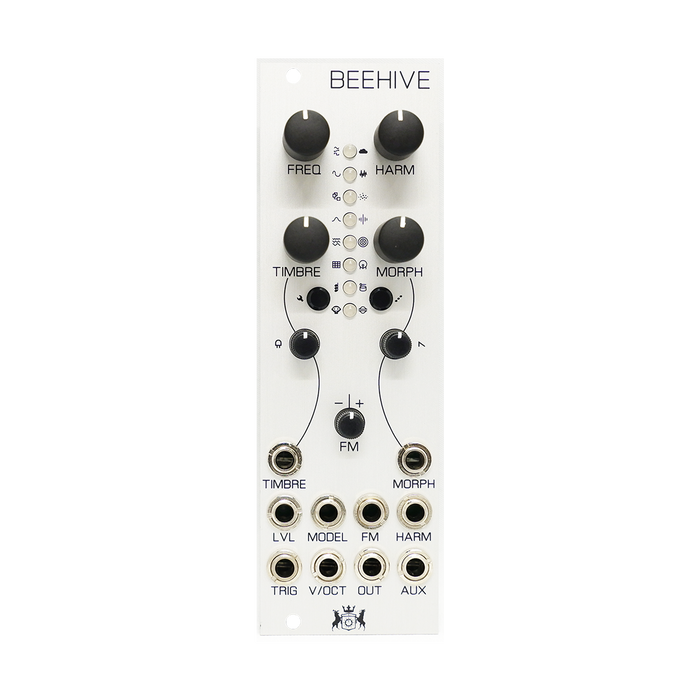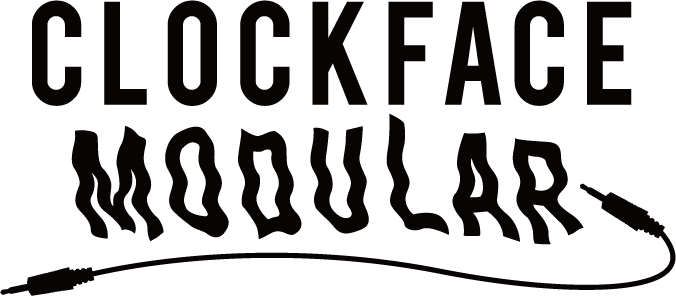MUSICAL FEATURES
Beehive isMutable Instruments PlatisThis is a synthesizer voice/oscillator module that has been cloned and compacted to 8HP. The last firmware released by Mutable Instruments is installed andOrange Bank's 16 algorithms in addition to the conventional 8 algorithmsSelect one from a total of 24 algorithms.To access a new bank, first press the two buttons at the same time for a moment to change the bank selection method to "Left button: next model, right button: previous model", then switch models. and an orange bank will appear.
Green algorithm: The following eight algorithms have pitch feeling.
- Standard waveform pair that changes continuously
- Waveform of a triangle wave with variable slope through a wave shaper or wave folder
- 2-operator FM with continuously variable feedback path
- Two independently controllable formants
- Harmonic oscillator that can control 24 overtone components
- Wavetable oscillator with four 8x8 table banks (both continuous and discontinuous change possible)
- Chord generator (Turning etc. can be controlled in addition to tone)
- Collection of human talking algorithms
Red Algorithm: The following eight noise and dissonance algorithms are easy to use for percussion.
- A sawtooth wave / sine wave that is granularly processed. Grain concentration, size, frequency randomization, etc. can be controlled.
- Clock noise passed through a resonant filter
- Particle noise passed through the resonator
- Extended Karplus-Strong model (a model in which noise burst is input to the Rings red mode)
- Modal resonator (model such as mallet or noise burst input to Rings green mode)
- Analog kick emulation (2 flavors)
- Analog snare emulation (2 flavors)
- Analog hi-hat emulation (2 flavors)
Orange Algorithm:
-
(1) Regular waveform with 4-pole/2-pole switchable filter
- (2) Phase distortion model
- (3) (4) (5) DX-2 style FM voices with 6 voices and 7 operators. Models 3-5 each support one bank of 32 presets, each of which is selectable in HARMO.It can be triggered duophonic and Level becomes velocity control. Timber controls the level of the modulator, Morph controls the time constant of the envelope, etc.DX-7 format SysEX files can be loaded(The use of the editor including the loading method is not supported, so please obtain it from the above forum)
- (6) Wave Terrain synthesis.Custom waveforms can be loaded via the editor.
- (7) String machine with stereo filter and chorus
- (8) 4 variable square waves.Chords and arpeggios are possible.
how to use
The main frequency control knob covers 8 octaves (it can also be set to a range of about 1 octave). Each model has three types of timbre parameters: Harmonics, Timbre, Morph. Attenuverter is attached to the CV control of Timber, Morph, and FM. CV control is also possible for model selection. Main 3V / Oct can be input from -1V to + 3V.
When patched to the trigger input, the oscillator will pass through the built-in digital low pass gate (LPG) and the gate will open with the trigger signal. Also used for drum triggers. The Level control is a CV input that can further control the volume of the oscillator and the size of the sound that passed through the LPG.
Some parameters can be adjusted by turning the knob while pressing the button. The LPG characteristics (morphing from VCFA type to VCA type) can be adjusted by turning the Timbre knob while holding down the left button. Adjust the LPG decay by holding down the same button and turning the Morph knob. Since it is an LPG type VCA, a unique lingering linger remains even if the decay is shortened. The LPG envelope is internally connected to the CV input of various parameters. If you want to disable those modulations, put the Attenuverter in the middle position.
You can switch the range and octave of the Frequency knob by turning the Harmonics knob while pressing the right button. In the setting where one of the eight LEDs is lit, the center is switched from C8 to C1 depending on the lit LED, and the Frequency knob moves only ± 0 semitones around it. When all LEDs are lit, use the Frequency knob to sweep 7 octaves as per the default settings.






